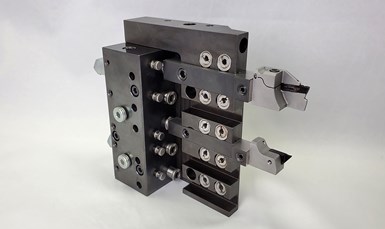Quick-Change Tooling Improves Swiss Lathe Profits
Two of the largest time sinks in Swiss turning are setups and tool changes. Swiss-type lathes make money thanks to the fast production of high-quality parts in large volumes, and any human intervention in that process is bound to cost time. Moreover, the tight work envelope often means that tooling is not easily accessible, which can add additional time to tool changes.
These problems are very familiar to Head of Product Management John Kollenbroich of Horn USA. “Changing out a tool often means truing the cutting edge and plumbing the toolholder if there is through-coolant,” he says. Truing can be time consuming, and getting it wrong can be costly. Because it involves positioning the tool against the OD, overtightening the toolholder can also chip the edge of the cutting tool you just spent ten minutes installing. To address these problems, Horn partnered with W&F Werkzeugtechnik to provide a faster way of changing out Swiss-type tooling, the W&F Linear Unit with Integrated Coolant Management System.
Modular, Quick-Change Swiss Tooling
The tooling systems are direct bolt-on blocks customized to replace the tool block of the user’s specific machine. The block has specially designed plumbing that enables the user to run high-pressure coolant by simply connecting two lines to ports on the block. The coolant is fed through the block and through HSK coolant tubes into the toolholders, which plug into plumbing ports at the bottom of each tool station. Additionally, the internal plumbing prevents chips from tangling in it. Helpfully, the coolant ports work with through-coolant tools from other suppliers, not just Horn USA.

The Linear Unit with CMS is a modular toolholding block designed to drastically reduce time needed for tool changes. The wedge clamps provide extremely rigid toolholding, while the screws are designed for ease of use during tool changes.
The plumbing ports at the bottom of each toolholder slot are vital to the benefits of this system, as they not only enable the user to quickly plug a toolholder into the plumbing, but they also provide a fixed distance for establishing the position of the cutting tool. The ports serve as stoppers, as the toolholder rests against them even when there is no through coolant. Because the length of the toolholder is known, and the stopper provides an exact position, the user can establish the position of a cutting edge without needing to true it. Instead, tool changes are a matter of pulling one toolholder out, replacing the insert, and plugging it back in.
Even without through coolant, the port still serves as an adjustable stop that the toolholder can press against to provide a known location. This enables the shop to prepare tooling ahead of time, making it a simple process to remove a toolholder and replace it with an already-prepared one.
Additionally, the system manages to eliminate human error in calculating offsets or placing coolant lines without eliminating the human presence. The tool stops provide accurate and repeatable tool locations while reducing setup time, and it does this without replacing a human operator. This means the number of errors reduces drastically without the need for complex automation systems.
A Robust Block for Quick-Change Tooling
While saving time is great, Swiss-type lathes depend on robust tooling blocks to ensure the finishes required for the parts they make. Improvements in turnaround do nothing if the machines cannot provide parts at the quality required, and that means tooling must be rigid. Fortunately, the Linear Unit with CMS is designed to provide quick-change capabilities without compromising the tooling parameters at all.

The plumbing inside the tooling block enables the user to simply plug the toolholder into a port, and the plumbing is done. The ports also serve as stoppers that create a fixed distance for establishing the position of a cutting edge.
The wedge-clamping system provides 40 kilonewtons of clamping force while only requiring 4 Newtons of pressure to turn. This means the clamps loosen and tighten easily while providing plenty of force to keep tooling rigid. Tightening and loosening the wedge requires adjusting a single screw, improving the speed of tool changes even further.
The rigid hold and stability of the tooling block is a good fit for other quick-change solutions, as well. For example, quick-change tooling heads that quickly screw into the ends of toolholders make it possible to switch out cutting inserts in a matter of minutes. Horn USA offers quick-change tool heads that provide repeatability within 2 microns, and users can switch them out using a single screw. Between the shortened setup time of the tooling block and the reduced tool-change time of the heads, these systems can save hours. “The time a shop spends changing its tooling is lost machining time,” says Kollenbroich. “These solutions help shops to reclaim that time.”

Quick-change tooling heads enable swiss-type machines to quickly change out tooling with repeatability within 2 microns. This combines with the linear unit to drastically reduce time lost to tool changes.
“A lot of this industry revolves around incremental improvements, getting a few seconds here and there,” Kollenbroich says. “But this quick-change block can save 10 minutes per tool change and hours per setup. Just eliminating the need to run the high-pressure lines through the tooling saves 10-15 minutes per station during setup.” The financial benefits are clear. “If it takes someone 30 minutes to change some tooling, and this can get it done in two, that’s 28 minutes of free production time,” he says, “If your machine runs 100 bucks an hour, every day, this system is saving 50 dollars five or six times a day.”
